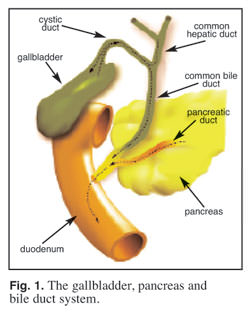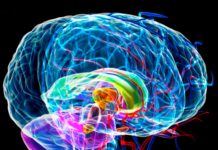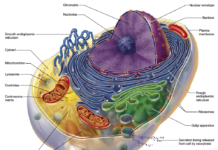Paul Anacker, J.D.
For the last six months I’ve taken part in a series of ongoing evaluation trials of new and pending herbal formulas. Before I share my thoughts on these formulas I think it would be helpful to begin with an overview of my recent health history.
Onset of Acute Pancreatitis
In August 1995, I was hospitalized with an extreme case of acute pancreatitis. I remained in the hospital for almost five months, including 110 days in the intensive care unit. My problem was caused by a blockage in my pancreatic duct, about a quarter of the way up from the common bile duct (Fig. 1). Because of this obstruction, pancreatic fluid that would normally be released into the intestines was blocked, building up in the pancreas and leading to the formation of several pseudocysts that eventually became infected abscesses. My surgeons attempted to perform endoscopic surgery to open the duct and insert a drainage stent, without success.

During my first hospitalization the doctors warned my folks that I wasn’t likely to survive on at least five separate occasions. When I was released at the end of 1995 my abdominal muscles were left cut apart and I left the hospital with five drainage tubes sticking out from my abdomen. Because of the severity of my pancreatitis (and the resulting diabetes), my doctors said that I had about eight years left to live.
After several years my Ventura surgeons finally gave up on me and sent me to the U.S.C. medical center in Los Angeles. My case intrigued the Director of the Pancreatic and Biliary Department and he took me on as a patient personally. Eventually he also gave up, telling me that the only remaining option was an operation to remove 80 percent of my pancreas and my spleen also. I resigned myself to having the operation, but fortunately the only surgeon who could perform this delicate operation was on vacation for a month.
Trying for a Natural Solution
While waiting for the surgeon to return from vacation I decided to put my research skills to good use. I’d already given conventional (Western) medicine a chance to try to heal me; now I decided to see if there was a natural approach to saving my pancreas and spleen.
When I reviewed the medical literature I discovered that several alternative doctors hypothesized that pancreatitis is a form of fibrosis (cross-linking of tissue). On the basis of their work I began to take four natural substances that, at that time, were believed to prevent, and perhaps reverse, fibrosis – EDTA, PABA, DMSO and MSM.
This was in October of 1998, and I’d already been living with a drainage catheter poking out of my pancreas and through my ribs for almost two years. To keep my catheter from clogging I had to irrigate it with a saline solution four times every day. Now, in addition to taking the four natural substances orally, I also added them to my saline irrigation solution.
Much to the amazement of my doctors, once I began treating myself I felt good enough to put off having the surgery. In fact, despite continuing to have chronic pancreatitis and being in constant pain that sometimes could debilitate me to the extent that I would have to stay in bed, I didn’t need to return to the hospital, let alone visit an Emergency Room, for another eight years.
Heart Problems
My next hospitalization occurred in November 2006. At the end of October I began to feel weak, and if I exerted myself I became dizzy. A week later, I was growing weak and dizzy just lying in bed, so I checked myself into the hospital for a series of tests. An Adenosine-Stress (AS) test revealed that my Ejection Fraction (EF), a measure of how much blood the heart is actually pumping, was down to 38 percent (by comparison, a healthy EF is 70 percent). An echocardiogram confirmed the decline in my ejection fraction, though it indicated an EF of 47 percent, not as bad as 38 percent, but still serious. Reviewing my echocardiogram numbers my MD said they were very close to the 48 percent EF rate measured by a Thallium-Stress test I had back in 2002.
Trying to understand why my heart was so weak I decided to take a look at the supplements I was taking. For several years I had been taking 1600 mg a day of Red Rice Yeast Extract to help control my cholesterol levels. Red Rice Yeast Extract contains lovastatin, the same active ingredient found in pharmaceutical statin drugs, such as Lipitor® and Zocor®. In addition to lowering cholesterol, statin drugs have the undesirable side effect of depleting Coenzyme Q10 (CoQ10) levels in the body.
CoQ10 is concentrated in the myocardium, or heart muscle. Its role in the heart makes sense: the heart, one of the body’s most energetic organs, beats approximately 100,000 times a day and 36 million times a year, and depends on CoQ10 for “bioenergetics.”
My test results led me to suspect that the Red Rice Yeast Extract I’d been taking may have severely depleted my CoQ10 levels and contributed to my heart weakness. I stopped taking the Red Rice Yeast Extract and added CoQ10 to daily supplement regimen, along with a Chinese herbal cardio-support formula.
A follow-up echocardiogram on Dec 1st showed that my ejection fraction had returned to normal, at 70 percent. This is an extremely fast turnaround! I don’t know whether to attribute this to the CoQ10, the herbal cardio-support formula, or both. But if I had it to do over again, I believe I would start with the herbal formula, because it is much less expensive than CoQ10.
Of course, my doctor had a completely different explanation when I met with her on Dec 22nd. When I told her that I was taking both CoQ10 and the herbal cardio-support formula, she told me that the original report from Nov 7th echocardiogram now showed an EF of 70 percent. There had been a mistake someplace, either in what they originally told her when I was in the hospital, or in the report of the hospital results she now had. Since echocardiograms are pictures “read” by experts, perhaps the earlier “reading” was revised as a result of the later “reading.”
Honestly, I’m not exactly sure where the mistake was made, but as a result I’m far less trusting of the accuracy of even the diagnostic tools of conventional medicine. However, a couple of other results cannot be simply “explained away” by conventional MDs claiming a mistake in test results.
Persistent Glucose Problems
Following my discharge from the hospital in 1995, my blood glucose readings have been consistently high, averaging about 300. I attribute the problem to the constant pain and illness from my chronic pancreatitis. Indeed, prior to 1998, when I was in the hospital for two weeks, my doctors had complete control over my nutrition and insulin dosage, and even they couldn’t get my readings below 300.
The good thing was that, because of all the supplements I was taking, I had been able to avoid many of the adverse effects that result from high blood glucose levels, such as cataracts, diabetic retinopathy, peripheral neuropathy, nephropathy, atherosclerosis and osteoporosis. In fact, after 10 years of high blood glucose levels my ophthalmologist was shocked to find that I had no signs of diabetic retinopathy (he was so amazed that he checked twice, more thoroughly the second time). The peripheral neuropathy of my feet and lower legs had been getting better over the years. And, of course, the MDs had just given my heart a good bill of health.
However, now my doctors were becoming alarmed at my elevated blood glucose levels and high hA1C test results. The glycosylated hemoglobin test (commonly referred to as hA1C) measures the average blood sugar level for the previous 3 months to determine overall diabetes control. According to the American College of Endocrinology hA1C levels should be under 6.5 for optimal health, but even keeping hA1C at or below 7 percent can help to minimize long-term complications associated with diabetes. My hA1C was up to 11.4.
To make matters worse, since I’d stopped taking Red Rice Yeast Extract my cholesterol levels were elevated and my blood pressure had shot up to 165/95 during the past few months. I was sent to a “diabetic specialist” who warned me of the cardiac complications that can result from constant high blood glucose. She increased my insulin regimen and wanted me to consider taking two prescription drugs – Actos® and Avandia®. However, since I have an intense aversion to synthetic drugs, I searched for information about those two drugs. That turned up some disturbing information, including warnings from the FDA about prescribing Actos and Avandia for patients who were taking insulin. As it turns out, these drugs greatly increase the risk of Congestive Heart Failure (CHF) when combined with insulin.
Once again, I chose to add some more natural supplements to my regimen. In particular, I added two new formulas used by clinicians and diabetic patients as part of an ongoing evaluation program. The first was an advanced glucose management formula. The second was an herbal formula designed to normalize and restore blood pressure to healthy levels. I began taking these on December 22, 2006.
I had more blood tests done in mid-January 2007. A week later I met with my primary doctor (who is, by the way, a first year intern DO, not MD, and supportive of my decisions to use natural substances instead of synthetic drugs, but has to deal with the “attending” MDs who supervise her and push the synthetic drugs). After approximately one month on the new supplements, my blood pressure had dropped to 123/77. More importantly, my hA1C level had been reduced from 11.4 to 7.7, and my 30-day blood glucose average was down to 146 (from my previous level of over 300). My cholesterol also significantly improved – I don’t remember the numbers right now, but they were low enough that my doctor said they were not of any concern.
Summary
Throughout the past four months, I have tried to convince the MDs to treat me, not my numbers. I believe the underlying cause of these numbers is the chronic insomnia caused by the pain of chronic pancreatitis. Instead of listening to my concerns, the MDs continued to attempt to treat my numbers with synthetic substances. However, I do not believe that my recent health problems are caused by a lack of some synthetic drugs that have been in existence for less than 10 years.
As I mentioned previously, I have a high disdain for synthetic drugs and the numerous side effects associated with them (in many cases, the side effects are more serious than the condition they are intended to treat). My philosophy is that our bodies evolved over millions of years in concert with nature and its abundance of natural healing substances. Consequently, our bodies have numerous metabolic pathways for these natural substances, and their safe use has been well established over several millennia.
In closing, I hope this information is helpful to you and your readers. Thanks again for allowing me to participate in the trials of your products, and I will keep you updated with future reports on my ongoing progress.
About the Author
Paul Anacker, J.D., passed away in May of 2008. Paul was deeply involved in the natural health field for over 30 years, beginning after a meeting with Jack LaLanne in the mid-60s, and continuing as Paul studied the works of Dr. Paul Bragg while attending UCLA in the 60s. Over the years Paul has served as a researcher and consultant to leading figures in the field of alternative medicine. In the mid-80s Paul served as lead editor and co-publisher of the groundbreaking book, Biological Aging Measurement: Clinical Applications by Ward Dean, M.D. In the late 90s he also served as a formulator for Body International, Inc. and assisted in designing formulas for leading supplement companies.













